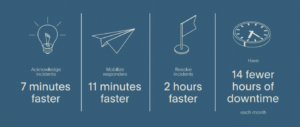What Operational Maturity Looks Like Today With PagerDuty’s Kyle Duffy
Companies that underwent accelerated digital transformations during the past 18 months are looking to understand how they can improve their operational maturity to handle the increase in complexity. This is paramount to an organizations’ future success. In fact, research that PagerDuty conducted with IDG found that, on average, organizations with a mature digital operations approach are able to achieve the following:
We sat down with Kyle Duffy, Vice President of Solutions Consulting at PagerDuty, to hear his observations about operational maturity and how customers embrace the model to level-up their organizations.
Q: You must spend a lot of time talking about digital transformation and how
technology leaders tackle their aspirations. Is there an inflection point that you’ve
noticed during your career?
KD: What I’ve noticed is the pace of change consistently accelerating every year. Market dynamics change incredibly quickly, which puts pressure on companies to innovate, and new technologies allow organizations to keep pace. The companies that are thriving haven’t just transformed their technology though, they’ve modernized the way they operate and reinvented their culture.
Q: PagerDuty has been championing digital operations maturity for years. Have you seen a change in organizations’ digital maturity in recent years?
KD: On the less mature end of the spectrum, we still see plenty of organizations that frequently learn about problems from their customers and operate from a reactive position. Reaching the most mature end of the spectrum is still elusive for most—and the bar keeps creeping up higher. What has changed is that the differentiation in maturity levels is more refined. Solving for handling real-time work has emerged as a cornerstone of being able to reliably and efficiently keep critical digital services and customer experiences working seamlessly.
Additionally, systems built for queued ticketed systems simply bog down the workflow and increase risk of sustained service disruption. We used to talk about the challenges of event volumes in fairly broad terms. Now, a lot of companies have solved for event noise and the associated disruption from alerts, and have moved on to the next stage of identifying more context around events. For example, how are these events related? What are the dependencies? Where is the root cause?
Q: As leaders and organizations mature along the model, what are the key areas of
marked growth/change? Are they still bogged down by the same problems?
KD: The challenges remain the same. Organizations that get bogged down tend to hesitate on making the biggest change, which is a cultural transformation to a service ownership model. For many, the people changes are actually harder than technology changes. But the payoff is huge—truly reinventing culture is the only way I’ve seen companies accelerate innovation, increase uptime, and reduce costs at the same time.
Another growth area, from a technology perspective, is shifting away from managing incident response processes in systems that are built for queued work. Today’s world requires systems built for real-time work. In that regard, PagerDuty is a big enabler of the cultural transformation to service ownership and all the benefits that come with it.
Q: What is the hardest part for organizations to uplevel their operational maturity? Any
tips on how to ease that transition?
KD: Resistance to change. You’ve got to find and embrace the people who are believers in transformational change and have the respect of the organization. They’ll be a big part of leading your team through this journey whether they have a title or not.
Q: Is there any low hanging fruit or advice you’d give to organizations who are struggling to break through from a reactive approach to adopt a more proactive posture?
KD: You don’t need to do it all at once. Change should be incremental. For example, when putting people on call for the first time as you shift to a service ownership model, start by putting them on call only during business hours so it doesn’t feel like a burden. What teams often realize is that it actually improves their quality of life, which makes them much more excited to go on call after hours. You should also focus first on the small subset of applications and teams that are needle movers for the business. You can’t afford for those to move slowly, so concentrate your energy there.
In other words, statistics and data about past incidents and practitioner response patterns fed continually into an AI model can help us confidently make assumptions if they are closely related to past incidents.
______________________________________
If you’re interested in learning more about how to benchmark and improve your operational maturity, download this eBook. If you want to learn how PagerDuty can help you achieve these goals, contact your account manager and sign up for a 14-day free trial.
